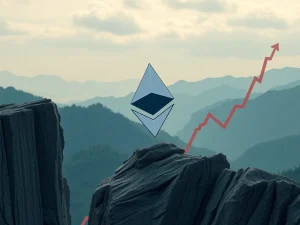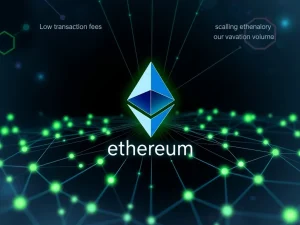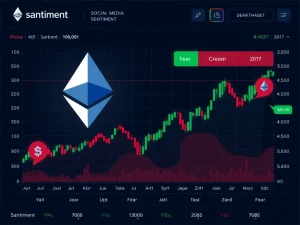Unlocking Ether ETF Potential: What Surging Inflows Mean for Savvy Crypto Traders

The cryptocurrency landscape is rapidly evolving. For a long time, Bitcoin dominated headlines, especially concerning exchange-traded funds (ETFs). However, a significant shift is now underway. Ether ETF inflows are capturing the attention of the market. They are redefining investment strategies for many. Smart crypto traders are closely watching this trend. Understanding these dynamics is crucial for navigating today’s digital asset markets. The rise of Ether ETFs signals a new era for digital finance. This development is truly transformative for institutional crypto adoption. It provides clear market signals that cannot be ignored.
The Ascent of Ether ETFs: A New Investment Frontier
Ether (ETH) is much more than a digital currency. It serves as the fundamental layer for decentralized finance (DeFi). Furthermore, it powers non-fungible tokens (NFTs) and smart contracts. This provides real-world utility, often exceeding Bitcoin’s scope. In 2025, Ether has achieved a major milestone. Spot Ether ETFs have emerged. These products offer institutional investors a regulated path to gain ETH exposure. This year, the investment narrative has broadened considerably. It no longer focuses solely on Bitcoin ETFs.
Recent data underscores this dramatic change. SoSoValue reported compelling figures for August 2025. Ether ETFs attracted a substantial $3.87 billion in net inflows. Conversely, Bitcoin ETFs experienced $751 million in outflows during the same period. This striking divergence fuels speculation. Many now consider the “flippening” a real possibility. This term describes a future where Ether could challenge Bitcoin’s market dominance. For discerning traders, this momentum is a vital signal. ETF inflows often precede significant ETH price movements. Therefore, paying close attention is essential.
Understanding Ether ETFs and Their Impact on Market Signals
Before diving deeper, let us define Ether ETFs and their inflows. An Ether ETF is a fund. It trades on traditional stock exchanges. Investors use it to gain ETH exposure. They do this without directly buying or storing the cryptocurrency. Importantly, two types exist. Spot ETFs hold actual Ether. In contrast, futures ETFs track ETH futures contracts. Inflows represent the net amount of money entering these ETFs. Positive inflows indicate strong demand and investor confidence. Conversely, outflows suggest selling pressure and reduced interest.
Current data highlights the market’s growth. As of late August/early September 2025, Ether ETFs hold approximately $28.8 billion in assets. This represents about 5.3% of Ether’s total market capitalization. Key players include:
- BlackRock’s ETHA ETF: Holds around $16 billion in net assets.
- Grayscale’s ETHE: Manages roughly $4.6 billion.
- Fidelity’s FETH: Has approximately $3.5 billion.
While Bitcoin ETFs remain larger, Ether’s momentum is undeniable. BlackRock’s IBIT leads Bitcoin ETFs with about $82 billion. However, the consistent Ether ETF inflows demonstrate a clear shift. These flows act as crucial market signals for any serious crypto trader. They indicate where institutional capital is heading. For example, on August 29, 2025, both Bitcoin and Ether ETFs saw simultaneous outflows. This followed hotter US inflation data. Such events show the market’s sensitivity to macroeconomic factors.
Why Traders Must Monitor Ether ETF Inflows for ETH Price Movements
ETF inflows are more than mere statistics. They function as powerful market signals. These signals reveal institutional investor positioning. Traders should closely monitor these numbers. They often align with significant changes in ETH price trends. Moreover, they influence overall market liquidity. The reasons why inflows matter for traders are clear:
- Institutional Sentiment: Increasing inflows show that major players are betting on Ether’s future. This includes hedge funds, pension funds, and asset managers.
- Liquidity Dynamics: Higher ETF demand typically removes ETH from exchanges. This reduces available supply. Consequently, it can push prices upward.
- Historical Parallels: Crypto ETFs saw about $7.6 billion in net inflows during 2021. This helped fuel Bitcoin’s rally to new all-time highs.
A recent event clearly illustrates this impact. On July 16, 2025, Ether ETFs recorded an astounding $726.6 million in single-day inflows. This was a record-breaking amount. It coincided with ETH testing the $5,000 level. Although a slight pullback followed, the correlation was evident. Later in August 2025, US spot Ether ETFs achieved their second-largest daily inflows. They reached $729 million. Days earlier, they had set a record of $1.02 billion. Over just three days, total inflows hit $2.3 billion. The cumulative total surged to a new peak of $12.1 billion. This occurred as ETH approached its all-time high. For informed crypto traders, platforms like SoSoValue, CoinShares, and Farside Investors offer crucial insights. These tools provide early indications of accelerating or slowing institutional flows.
Short-Term ETH Price Action: How Inflows Drive Volatility
Ether ETF inflows can significantly shape short-term ETH price action. Billions of dollars moving into ETFs directly impact the market. The available ETH supply on exchanges decreases. This creates upward price pressure. However, it also fuels volatility. Markets can often overreact to these shifts. Therefore, traders must understand these short-term impacts:
- Price Momentum: Inflows frequently generate price surges. For instance, ETH rose over 40% in July 2025. This provides a clear example.
- Volatility: ETH dropped 4% in 24 hours. This happened after it failed to hold $5,000. This occurred despite strong inflows. Traders must prepare for sudden pullbacks.
- Options Market Impact: Rising inflows increase implied volatility. This creates opportunities for options sellers. They can capture premium.
- Arbitrage Potential: Price gaps can emerge. These occur between ETF shares and ETH spot markets. Sophisticated traders can exploit these differences.
Savvy crypto traders employ various strategies. They monitor momentum during inflow surges. They also hedge exposure using futures or options when inflows peak. Furthermore, watching ETH reserves on exchanges acts as an early warning system. This helps anticipate potential price squeezes. Short-term traders can profit from volatility. However, they must maintain strict risk management. Sudden reversals are common in crypto markets. Therefore, discipline is paramount. Did you know? Ether reached a new all-time high of $4,945 in August 2025. This surpassed its November 2021 record of $4,878. Institutional inflows fueled this fresh momentum.
Institutional Crypto Integration: Ether ETFs and the Long-Term Outlook
Beyond short-term fluctuations, the rise of Ether ETF inflows signals deeper institutional adoption. This trend has profound implications. It affects long-term stability and liquidity. It also solidifies ETH’s role as a global financial asset. Corporate treasury adoption is clearly growing. SharpLink Gaming, for example, added over 800,000 ETH to its balance sheet this year. ETHZilla also increased reserves to more than 102,000 ETH. BitMine Immersion Tech holds over 1.8 million ETH. This makes it the largest publicly traded ETH holder.
Institutional sentiment is noticeably shifting. VanEck CEO Jan van Eck famously called ETH “the Wall Street token.” He emphasized its role in stablecoin transfers and financial infrastructure. Currently, ETH ETFs represent over 5% of total ETH market capitalization. This marks a significant milestone for mainstream adoption. Potential long-term benefits include:
- Greater liquidity: ETF participation deepens, reducing volatility.
- New demand: Pension funds, family offices, and insurance companies will invest.
- Increased integration: ETH will further integrate into traditional financial systems. This is especially true if staking is approved for ETFs by late 2025.
Ether’s utility extends beyond being a mere store of value. Its integral role in DeFi and enterprise applications makes it highly attractive. Consequently, it stands as a compelling long-term institutional crypto asset. These developments provide strong market signals for future growth.
Navigating Risks: Challenges for Crypto Traders Amidst ETF Growth
Despite the impressive growth of Ether ETF inflows, traders should remain vigilant. Several key risks could impact the market. These challenges affect both retail and institutional participants. Prudent crypto traders must consider these factors:
- Regulatory Uncertainty: US lawmakers have introduced measures. These include the GENIUS Act and CLARITY Act. These are steps toward clearer crypto rules. However, regulation remains unpredictable. The US Securities and Exchange Commission (SEC) could quickly change its stance. New restrictions on ETF approvals, staking features, or compliance requirements could reduce institutional demand.
- Competition with Bitcoin ETFs: Bitcoin ETFs still dominate the market. They hold over $100 billion in assets. BlackRock’s IBIT leads with around $82 billion. While ETH ETFs gain traction, Ether must sustain inflows. This will prove its long-term staying power. Traders should remember that Bitcoin remains the benchmark institutional asset. This may limit ETH’s momentum.
- Over-reliance on ETFs: Strong inflows often create bullish narratives. However, heavy outflows can just as easily spark sharp declines. Traders should avoid basing decisions solely on ETF data. Instead, they should consider other signals. These include exchange reserves, technical analysis, and macroeconomic conditions. A diversified approach reduces risk. It prevents being caught off guard by sudden market reversals.
- Volatility in Early Phases: Ether ETFs are still new. Like Bitcoin ETFs in their early years, they may bring heightened volatility. Price swings of 10% or more are possible. This can happen even in response to modest news events. Traders must employ robust risk management. This includes stop-loss strategies, proper position sizing, and hedging. These tactics help overcome early-phase turbulence.
Understanding these risks is vital. It allows traders to make informed decisions. Furthermore, it helps protect capital in a dynamic market. The long-term trajectory for institutional crypto adoption looks positive. Nevertheless, short-term challenges persist. Therefore, continuous vigilance is key for every crypto trader navigating the evolving landscape of ETH price movements and market signals.










